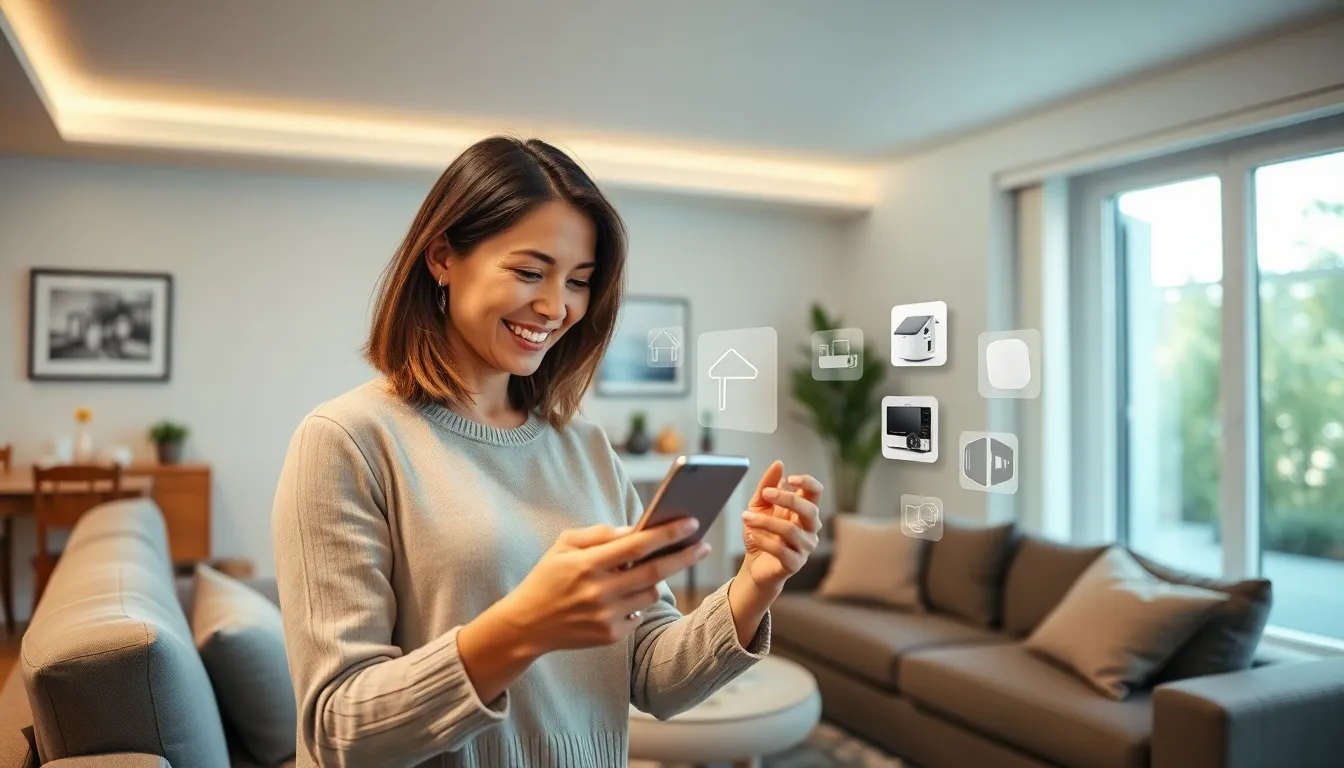Imagine walking into your home and having the lights turn on, the thermostat adjust to your preferred temperature, and your favorite playlist start playing—all without lifting a finger. Welcome to the world of IoT home automation, where everyday tasks become a breeze and your home practically caters to your whims.
Table of Contents
ToggleOverview of IoT Home Automation
IoT home automation refers to the integration of smart devices within a home network to enhance convenience and efficiency. Users control lights, thermostats, and entertainment systems through smartphones or voice-activated assistants. Smart home devices function seamlessly, reacting to user preferences and schedules.
Most smart home systems utilize Wi-Fi or Zigbee protocols for communication. This connectivity enables users to monitor and manage devices remotely. For example, adjusting the heating or cooling before arriving home becomes effortless.
Security also benefits from IoT home automation. Surveillance cameras and smart locks provide enhanced safety, allowing homeowners to receive real-time alerts on their mobile devices. In this way, potential intrusions can be addressed immediately.
Energy efficiency is another major advantage. Smart thermostats learn user patterns, optimizing energy use based on occupancy. Thus, unnecessary energy consumption decreases significantly, contributing to lower utility bills.
Various platforms exist for IoT home automation, including Google Home, Amazon Alexa, and Apple HomeKit. These ecosystems offer compatibility with diverse smart devices, making it easy to create customized home environments. Users can choose devices from different manufacturers, enabling them to mix and match according to their needs.
Underpinning the growth of IoT home automation, advanced machine learning algorithms enhance device functionality. With continuous improvements, users anticipate greater interconnectivity and automation in their daily lives. The increasing availability of affordable smart devices accelerates the shift towards fully automated homes, shaping the future of living spaces.
Benefits of IoT Home Automation
IoT home automation offers numerous advantages, enhancing both convenience and security for homeowners.
Increased Convenience
Convenience dramatically improves with IoT home automation. Smart devices enable seamless control over lighting, HVAC systems, and entertainment equipment. Users can manage these systems via mobile apps or voice commands, creating a responsive and user-friendly environment. Customization options exist, allowing individuals to set schedules for various tasks like adjusting thermostat temperatures and dimming lights at specific times. Compatibility among devices from platforms like Google Home and Amazon Alexa fosters a unified approach, simplifying everyday tasks. Notifications keep users informed of the home’s status, enhancing peace of mind while away.
Enhanced Security
Security benefits significantly from IoT home automation. Smart locks provide keyless entry, allowing users to control access remotely. Surveillance cameras equipped with real-time alerts enhance monitoring capabilities, deterring potential intruders. Integration of motion sensors further strengthens security measures, immediately notifying homeowners of any unusual activity. Anomalies trigger alerts, assuring timely reactions to potential threats. Additionally, IoT systems can be programmed to emulate regular occupancy patterns, minimizing risks during periods of absence. Overall, the advanced security features foster a safer domestic environment for residents.
Popular IoT Home Devices
IoT home automation features various smart devices that enhance convenience and security. Here are some of the most popular options.
Smart Lighting
Smart lighting systems allow users to control home illumination remotely. These devices connect via Wi-Fi, enabling adjustments through mobile apps or voice commands. Users can set schedules, change colors, or dim lights effortlessly. Energy efficiency is another benefit, as smart bulbs can significantly lower electricity usage. For example, some models automatically turn off when no one is present. Companies like Philips Hue and LIFX provide a wide range of customizable lighting options.
Smart Thermostats
Smart thermostats provide precise temperature control, learning user behavior over time. These devices optimize heating and cooling based on occupancy and preferences, reducing energy waste. The ability to adjust settings remotely adds convenience; users can ensure comfortable temperatures upon arrival. Popular models include the Nest Learning Thermostat and Ecobee SmartThermostat. Both platforms offer features such as weather updates and energy usage reports, enhancing both comfort and efficiency.
Security Cameras
Security cameras enhance home safety by offering real-time monitoring. These devices often feature motion detection, sending alerts directly to smartphones when unusual activity occurs. High-definition video streaming ensures clear visuals, even in low light. Many systems integrate seamlessly with other IoT devices, allowing for automated security responses. Brands like Ring and Arlo provide options with cloud storage and two-way audio for comprehensive security solutions.
Challenges and Considerations
Several challenges and considerations arise with IoT home automation, including privacy and compatibility.
Privacy Concerns
Privacy remains a critical issue in IoT home automation. Smart devices often collect personal data, making it essential for users to understand what information is stored and shared. Security breaches can expose sensitive data, highlighting the risks of interconnected systems. Many homeowners worry about unauthorized access to their networks, as malicious parties can potentially exploit weak points. Implementing strong authentication measures and regular software updates can mitigate these risks. Awareness about data privacy policies established by device manufacturers serves as an important factor in maintaining user trust.
Compatibility Issues
Compatibility poses another significant challenge. Various manufacturers provide a wide array of smart devices with differing protocols and standards. Users often encounter difficulties when trying to integrate devices from multiple brands seamlessly. Not all platforms support each smart device, complicating the user experience. Moreover, outdated devices may lack the necessary updates for successful integration. Planning ahead and selecting devices compatible with main platforms like Google Home, Amazon Alexa, or Apple HomeKit can reduce these issues. Researching interoperability can save time and enhance usability within a smart home ecosystem.
Future Trends in IoT Home Automation
Emerging technologies are shaping the future of IoT home automation. Artificial intelligence advancements drive intelligent systems that learn user preferences. Increased adoption of 5G technology enhances connectivity, enabling faster device communication and response times. This shift allows for more complex automations, bringing greater seamlessness in home management.
Voice-activated interfaces are becoming a standard feature in smart homes. Consumers now prefer controlling devices using conversational interactions, simplifying user experiences. Smart assistants from platforms like Amazon Alexa and Google Assistant enhance this trend, integrating with various home devices. Users gain hands-free convenience, making daily tasks more efficient.
The focus on energy efficiency continues to grow. Smart devices are designed to optimize consumption, reducing utility costs and environmental impact. For instance, innovative thermostats adjust temperatures based on weather patterns and user habits. Additionally, solar-powered devices are gaining traction, promoting sustainability in home automation.
Privacy and security concerns remain central to guiding device development. Companies prioritize robust encryption and privacy policies, putting consumer trust at the forefront. Users increasingly demand transparency regarding data collection and usage practices. Addressing these issues leads to increased acceptance of smart technology in households.
Compatibility among devices is improving. Standardization efforts by various manufacturers aim to eliminate integration challenges, ensuring devices from different brands work together smoothly. This progress enhances user satisfaction, making IoT home automation more appealing.
Smart home health monitoring systems are also on the rise. These technologies track users’ health metrics, allowing for timely alerts and interventions. Health-focused innovations, like smart medication dispensers, support elder care and independent living, broadening the scope of home automation applications.
Conclusion
IoT home automation represents a significant leap towards smarter living. By integrating various devices into a cohesive network, homeowners can enjoy unprecedented control over their environment. Enhanced convenience and security are just the beginning; energy efficiency and customization offer tangible benefits that improve daily life.
As technology continues to advance, the potential for IoT home automation will only grow. Emerging trends like AI and 5G are set to transform user experiences further, making homes even smarter and more responsive. While challenges such as privacy and compatibility remain, proactive measures can help users navigate these concerns effectively. Embracing IoT home automation not only enhances comfort but also paves the way for a more sustainable and secure future.




